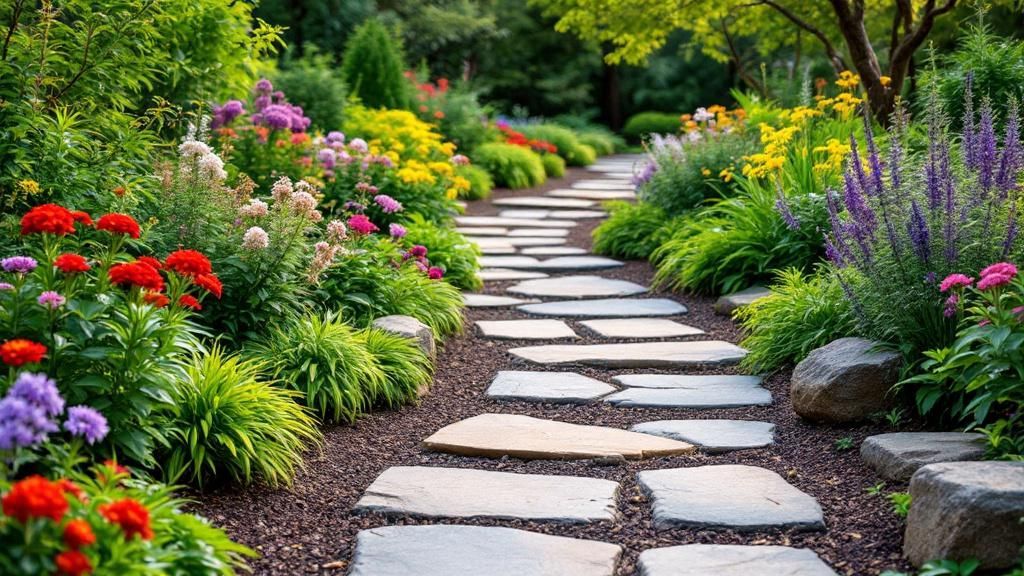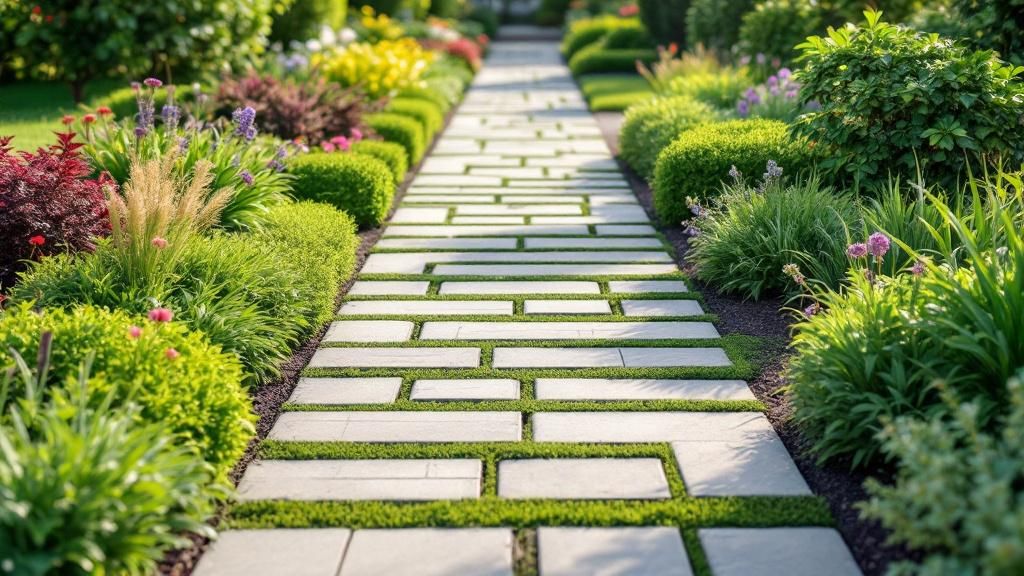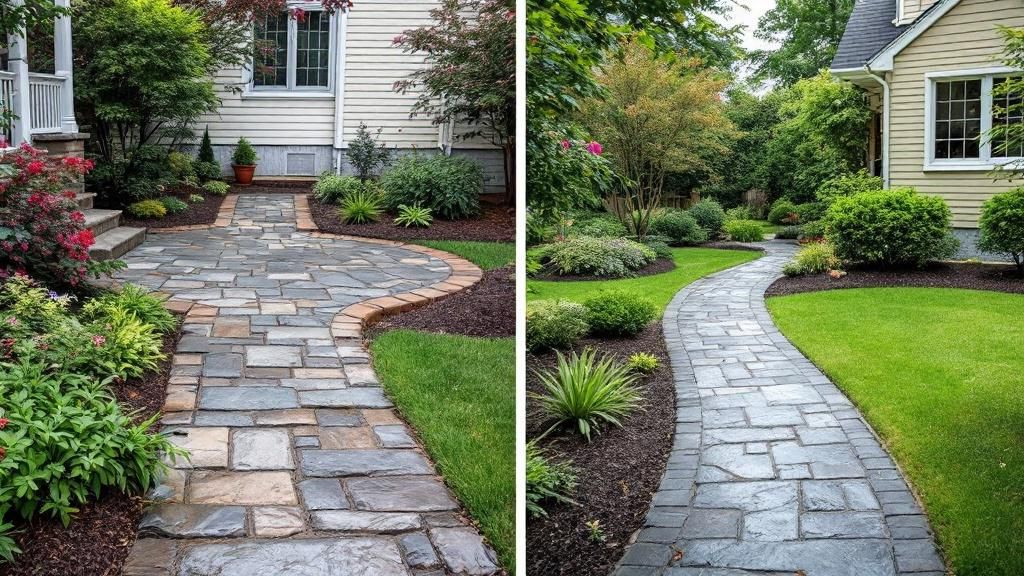
Designing Natural Pathways for Anchorage Homes: Function Meets Aesthetic
Key Takeaways
-
Natural pathways improve the usability and curb appeal of Anchorage yards year-round.
-
Choosing materials suited to Alaska’s freeze-thaw cycle is essential for long-term durability.
-
Grading, drainage, and edge detailing protect your investment from erosion and shifting.
-
Integrating pathways with plants and hardscaping features adds both structure and charm.
-
Professional help ensures pathways are code-compliant and built for local conditions.
Walkways may seem like a small detail in landscaping, but they define how people move through and interact with a space. In Anchorage, where snow, ice, and uneven ground can be year-round challenges, well-designed residential pathways are more than aesthetic—they’re practical necessities.
Natural pathways offer homeowners a safe, structured way to access gardens, patios, utility sheds, or driveways without creating ruts or tracking mud. They also guide the eye through the landscape, creating focal points and enhancing curb appeal.
Materials That Work in Anchorage’s Climate
Choosing the right materials for your walkways is key. Anchorage’s cold climate and seasonal shifts demand durable, weather-resistant options. Below are a few materials commonly used in local residential projects:
-
Gravel: Cost-effective and quick to install. Gravel drains well and suits casual, rustic yard layouts. It does require edging to prevent migration and may need periodic leveling.
-
Flagstone or Slate: These offer a natural, elegant look and perform well in cold temperatures. Stones must be properly spaced and installed over a solid base to avoid heaving during freeze-thaw cycles.
-
Concrete Pavers: Interlocking pavers are ideal for walkways, driveways, and patios. They’re stable, easy to replace individually, and can be arranged in many patterns for a clean or decorative finish.
-
Mulch Paths: While not as permanent, mulched paths are soft underfoot, visually organic, and ideal for low-traffic garden areas.
The most successful projects often blend two or more materials for visual contrast and functional advantages.
Design Considerations for Natural Walkways
Effective pathway design starts with more than picking a material. Consider how your walkway will function year-round in Anchorage’s unique environment:
1. Drainage and Grading
Paths should gently slope away from your home to prevent water pooling or ice formation. Installing crushed rock or a compacted base layer beneath pavers helps promote drainage.
2. Width and Layout
Residential pathways should be at least 36 inches wide to accommodate two-way traffic or snow removal equipment. Meandering paths feel more natural in large spaces, while straight lines suit smaller or more formal yards.
3. Edging and Containment
Edging materials like metal, stone, or treated wood help maintain clean lines and prevent gravel or mulch from spilling into adjacent garden beds.
4. Integration With Landscape
Paths should connect the most-used zones in your yard: garden beds, seating areas, fire pits, utility sheds, and more. Using native plants and mulch around your path softens the hardscape and improves soil retention.
Safety and Maintenance Considerations
Anchorage residents know the importance of winter-proofing outdoor surfaces. Pathways require the same level of attention:
-
Slip-Resistant Textures: Choose materials with some texture, like rough-cut stone or permeable pavers, to reduce the risk of slipping on icy days.
-
Snow Removal Access: Ensure that your pathway widths and layouts allow for easy shoveling or snow blower access.
-
Seasonal Inspections: Each spring, inspect your paths for frost heave, cracks, or drainage issues. Early repair can prevent more expensive problems down the line.
Enhancing Your Landscape With Walkways
Incorporating walkways into your landscaping allows you to:
-
Define Outdoor Zones: Use paths to lead guests from the driveway to your front door, or from your deck to the vegetable garden.
-
Improve Visual Flow: Thoughtfully placed curves, staggered pavers, or symmetry in design help the landscape feel more intentional and refined.
-
Increase Property Value: Professionally built hardscapes signal quality to potential buyers and reduce the appearance of yard maintenance issues.
Titan has specialized in helping homeowners incorporate natural walkways into their yards, ensuring each path is built for beauty and endurance—no matter the season.
Frequently Asked Questions
What’s the best material for Anchorage walkways?
Concrete pavers and natural stone are popular due to their durability and resistance to Alaska’s seasonal cycles. Gravel is also effective when properly installed with edging.
How do I prevent pathways from heaving in the winter?
Start with a deep, compacted base of crushed gravel and use materials that accommodate freeze-thaw expansion. Proper grading and drainage are key.
Can I build a walkway myself?
DIY is possible for small gravel or mulch paths. However, professional help is recommended for paver, stone, or sloped designs to ensure longevity and code compliance.
How wide should my walkway be?
For primary paths, aim for at least 36–48 inches. Garden paths can be narrower, but accessibility and snow management should always be considered.
Do walkways increase home value?
Yes. Clean, functional hardscapes enhance curb appeal, usability, and overall impression of property maintenance.
Walking Into a More Beautiful Yard
Whether you’re refreshing a backyard, installing a garden walkway, or creating a multi-functional outdoor space, well-designed pathways are key. Not only do they improve movement through your yard, but they also define the character and purpose of your landscape.
If you’re unsure where to start, working with an experienced Anchorage team can make all the difference. Titan is known for crafting natural pathways and landscape design brings together artistry and practical know-how to elevate residential properties across the region—one step at a time.

